Black scalar: what do fish look like and how to care for them?
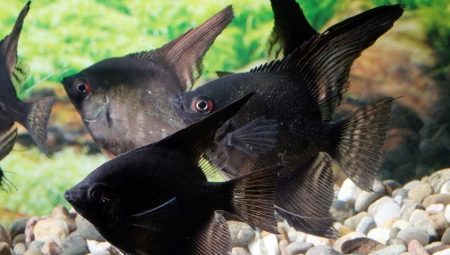
They say that nature did not come up with black. The scalar aquarium fish would argue with this statement if it could speak! An amazingly beautiful, glossy black scalar native to South America, the Orinoco and Amazon basins. In the last century, this species was first brought to Europe. However, those fish that now live in many aquariums around the world are the result of selection, and not wild representatives of the species.
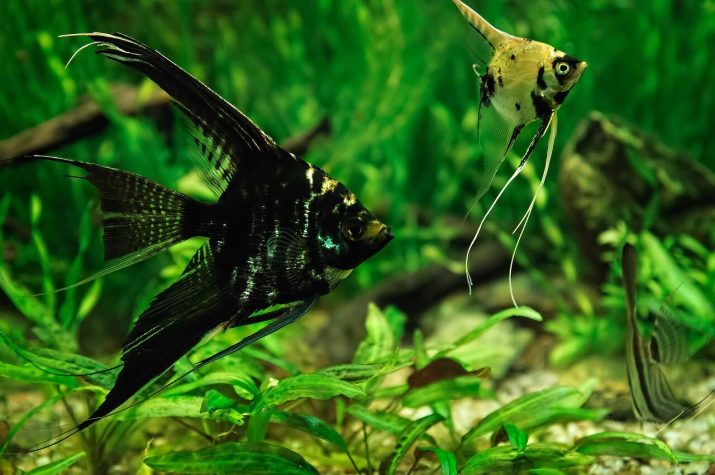
Description
The aquarium velvet black scalar is a form of the common scalar (Pterophyllum scalare), created due to the mutation of the dark gene Dark. All of its velvety species are extraordinarily beautiful and popular with aquarists.
This breed was bred selectively in Detroit (USA) in the middle of the 20th century. Her body and fins seem to be woven from black velvet, and her eyes are framed by red rims. Finding the perfect clean specimen without any blemishes or shiny scales is insanely difficult. To preserve the purity of the breed, serious breeding work is needed.
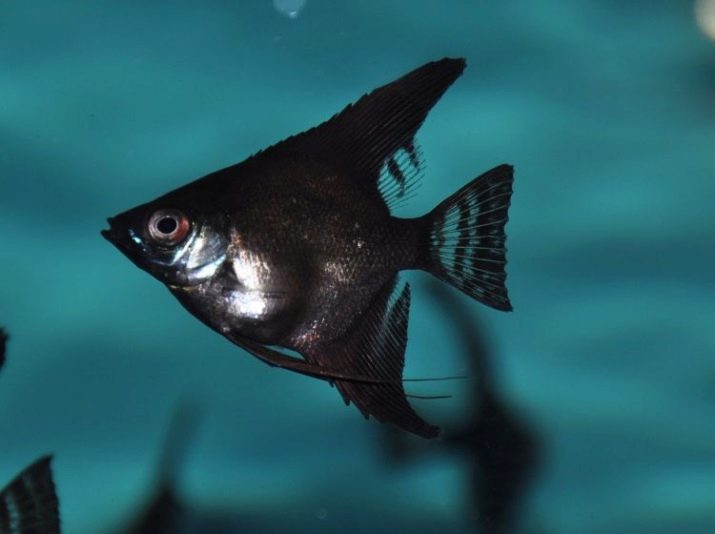
There is also a veiled scalar - a subspecies of black - which got its name from its characteristic thin tail, which resembles a silk female veil.
Among the varieties of scalars, there are also white, blue, and red individuals.
Important: scalars are monogamous fish. If the black scalar's partner dies, it may jump out and suffocate, or be forever alone.

In nature, there were originally three main types of scalars, from which a huge number of subspecies with color variations were subsequently bred. These color changes are associated with a gene mutation. A velvety black hue is caused by a mutation of the D gene, which is found in the natural color of the fish.
In the 1950s, the first attempts were made by breeders to develop new forms of scalar. The achieved look was then called the classic lace. The lace angelfish was blacker than that of the wild. Subsequent experiments with the accumulation of the dark gene led to the emergence of that very black scalar.
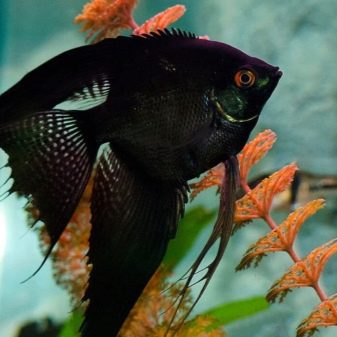

The standard black scalar reaches a length of 25 cm, therefore, for a comfortable life, it needs a fairly spacious aquarium (from 80 liters).
The cost of the scalar is calculated based on its type and age. Malek can cost less than a dollar, but an adult can cost from 10 dollars.
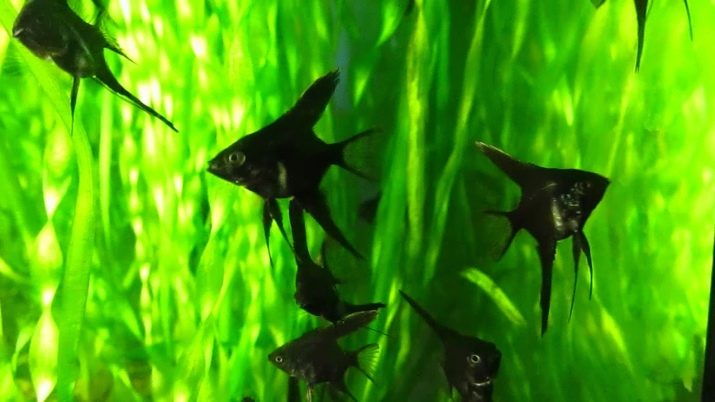
The black scalar has a number of advantages as a type of domestic fish:
- unpretentiousness and ease of care - the scalar does not require special food or sophistication in maintenance;
- beauty is a fish, indeed, it looks very "stylish" - if so, in general, one can say about a fish;
- character - the scalar is a calm fish that gets along with almost any other species.
An excellent choice for both beginners and advanced aquarists.
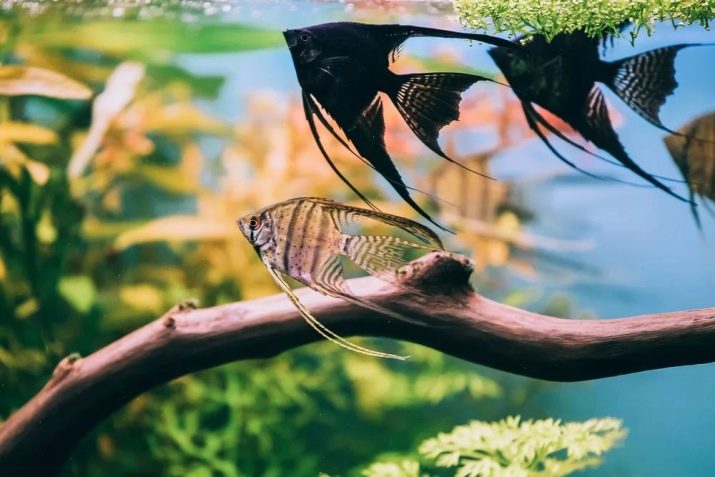
Let's see what other types of aquarium scalars exist.
- Ordinary. Its length reaches 20 centimeters. Due to its silvery color and the unusual shape of the fins, it is called in another way - the fish-month.
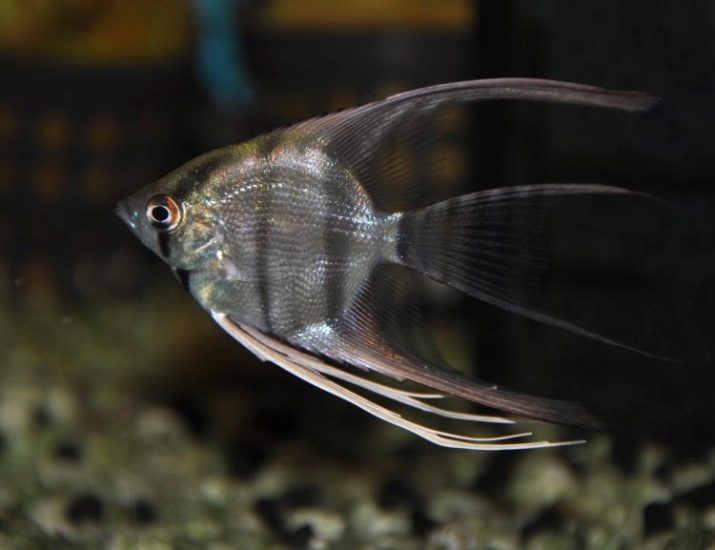
- Scalaria Leopold. A relatively small individual - up to 15 centimeters in length. It is also called long-nosed because of the protruding front of the calf. Its color is rather dull, but you can see dark stripes on brown scales.
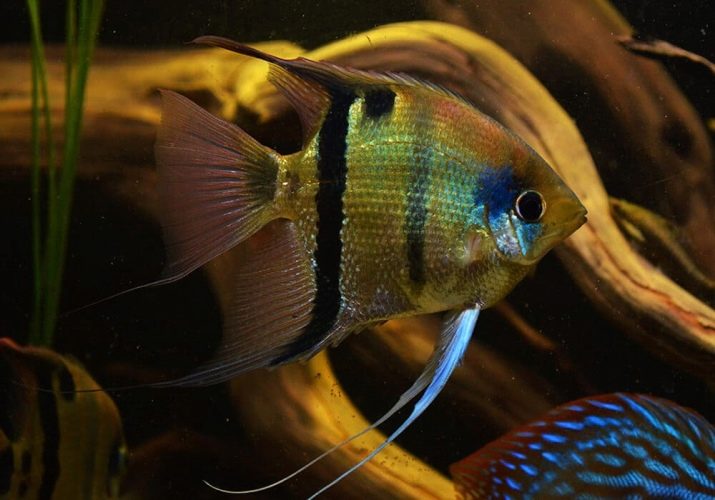
- Bicolor. In this breed, it is as if two fish are crossed: half of its body is black (usually the tail), half is silver. There is a clear border between the two colors.
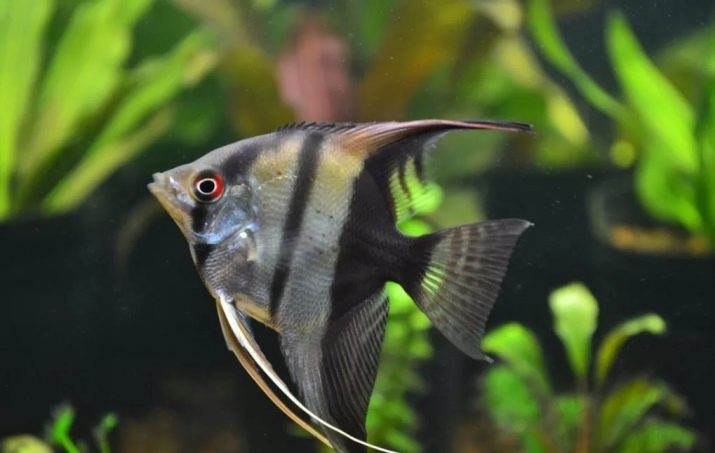
- Platinum. It has an iridescent light silver color.
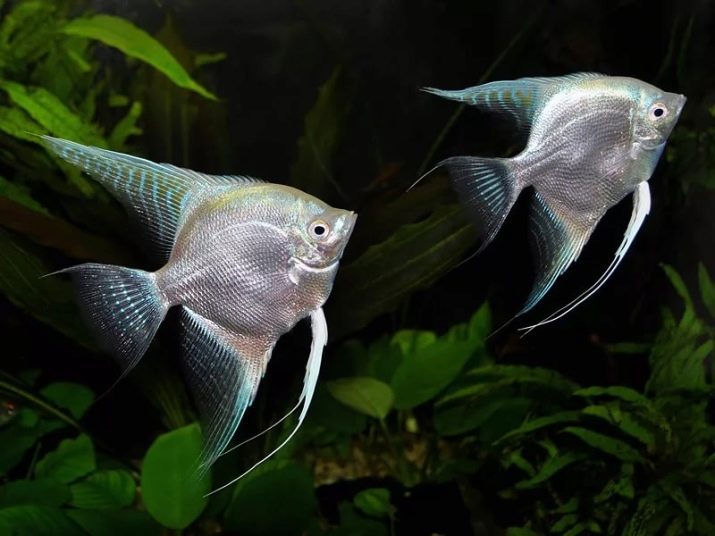
- Gold. The ancestor of this species is the common scalar. It is a fish with silver scales, in places covered with golden stripes. There may be more or less such gold patches, depending on the individual.
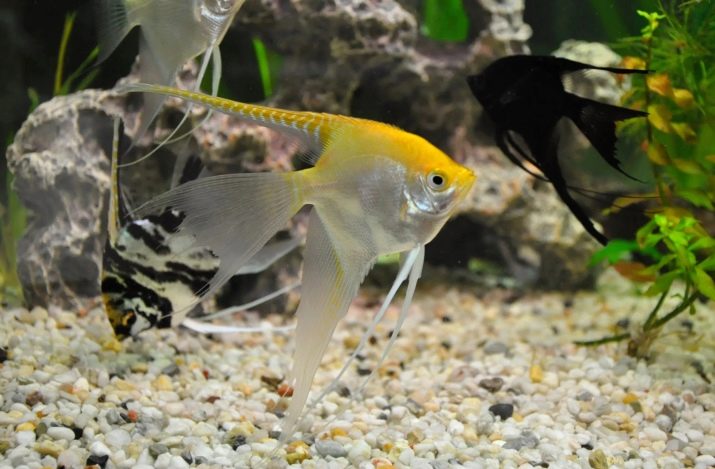
- Diamond. A relative of the golden scalar. The silver color of the scales plays beautifully in the light; the fins of this individual are almost transparent and thin.

- Blue. The second name is very gentle - blue angel. She has a very rich color shade. One of the most expensive types, its cost reaches one and a half thousand rubles.
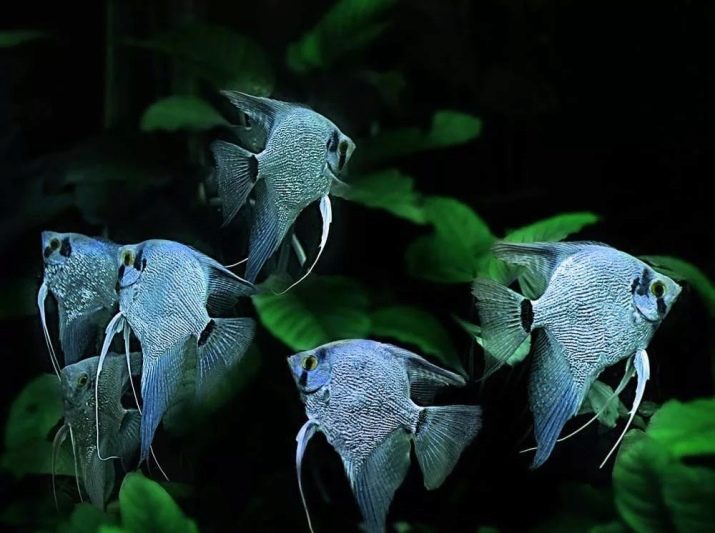
- Veiled. It got its name from the specific elongated translucent fins. It is better not to settle these individuals together with aggressive breeds of fish (for example, cichlids or barbs), since veiled scalars are rather slow and clumsy, which can irritate more active fish. Ideal neighbors are goldfish and benthic individuals (scalars do not sink to the bottom, but live mainly in the middle part of the aquarium).
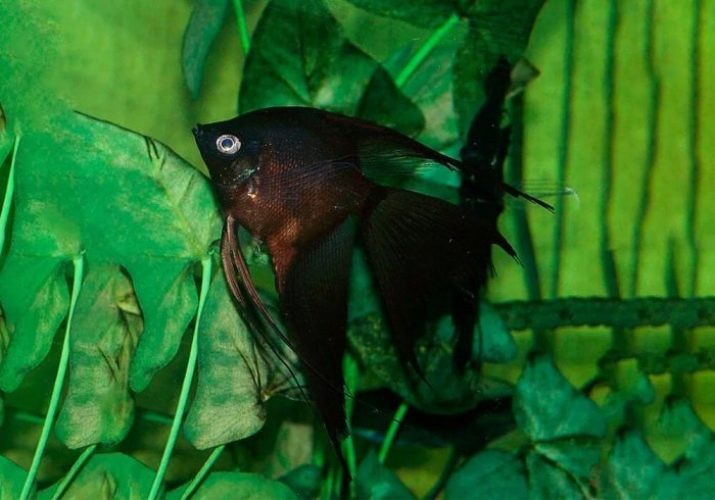
- High fin (altum). Wild individuals are famous for their huge size - about 50 centimeters in height. Outwardly, it is very similar to the common scalar, but the altum has a clearer pattern on the body. This individual is wayward and capricious, it will be uncomfortable in an overcrowded aquarium.
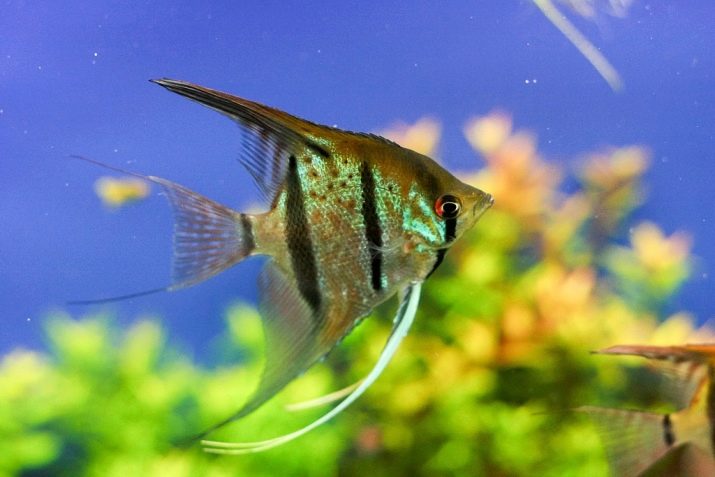
Features of the content
Caring for a black scalar is rather non-trivial. Like any other fish, it loves crystal clear water (+24.28 degrees Celsius), which must be changed regularly. Change some of the water to fresh water once a week. Filtration and aeration of the aquarium should be good: due to lack of oxygen, the fish may die.
Any hardness and acidity of water in the aquarium is permissible. She avoids bright light, because she mainly lives below or in the middle layer of the aquarium world.
She is not capricious in food: both ordinary dry food and delights like shrimps are suitable for her.


Wild angelfish are carnivores by nature. Their diet is small fish, invertebrates. And the aquarium species are omnivorous, but you should not feed it with a pipe maker! Because of it, the scalar quickly gains weight, stops multiplying, or even dies.
To maintain health, plant components should be periodically added to the diet.
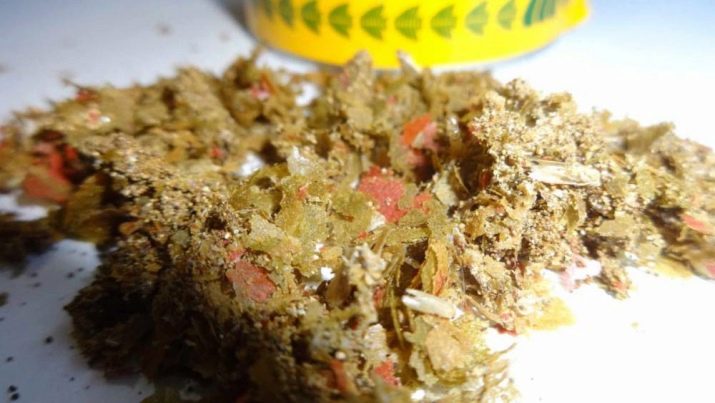
Create a "homey atmosphere" for the scalar: Populate the tank with dense plants to hide behind, add corals, but leave some free space for them to turn around.
Since scalars love to huddle in flocks, it is better not to start them one by one. These fish live in pairs, so there should be equal numbers of males and females.
An interesting fact: if you forcibly move a couple of fish, which themselves "did not choose" each other, into a separate aquarium, then they will eventually give offspring, but they will not take care of the caviar. "Marriages of convenience" are untenable in their midst.

The life cycle of a black scalar reaches an average of 10 years.
Before starting a scalar, you should familiarize yourself with the diseases that can affect them. All of them are mainly associated with metabolic disorders, poor hygiene or poor conditions in the aquarium.
If there is not enough oxygen in the water and poor aeration, the scalar will have breathing problems, they will float to the surface to catch air bubbles with their mouths. The eyes will fade, and the gills inside will be covered with necrotic gray spots. When these “bells” appear, immediately increase aeration, adjust the temperature and supply oxygen.
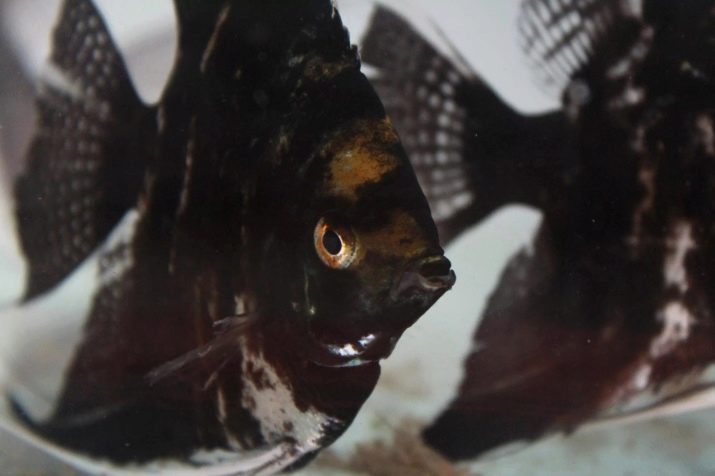
When the fish becomes lethargic, swims slowly and reluctantly, the anus becomes inflamed - most likely, the scalar fell ill with hexamitosis. This is a disease of the gastrointestinal tract of parasitic etiology. The main thing is to start medication on time so that the infection does not spread to other fish in the aquarium. Treatment is usually carried out with erythrocycline baths (50 grams) with trichopolum (10 grams) per liter of water.
Rod-shaped bacteria are also dangerous. - they provoke the development of fin rot in scalars. If you rarely change the water in the aquarium, pathogenic microorganisms quickly begin to multiply in the water. How to recognize this disease: the body of the fish is covered with white cloudy spots, the corneas of the eyes fade; at an advanced stage, the fin rays begin to detach, and ulcers appear. The consequences can be sad, up to and including death.
The treatment regimen is as follows: mix a solution of green malachite (0.1 mg), hydrochloride (100 mg), bicillin-5 (4000 units) in a liter of water. This solution must be poured into the aquarium and additionally treated with it for aquarium decorations, plants, corals.
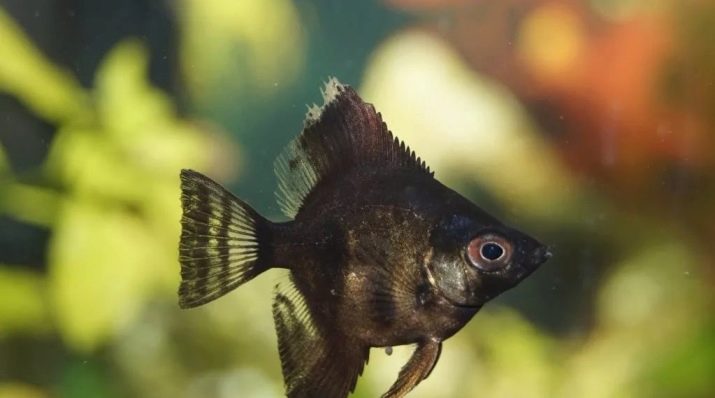
Breeding
First, let's figure out how to tell a male from a female. This delicate issue can be resolved only at the time of puberty of the fish, that is, it is possible to determine the sex of the scalar only by the second year of life. In the male, the front fin bifurcates, the forehead becomes convex and enlarged. In general, the boy is visually larger than the girl. In the female, the abdominal region protrudes, a noticeable tubercle appears in the genital area. The surface of its front fin is smoother than that of the male.
Breeding black scalar is not easy, and you need to have sufficient experience to do this. To breed fish, you will need a voluminous aquarium with aquatic plants, preferably flat-leaved ones.
Maintain the temperature at + 27.28 degrees Celsius.
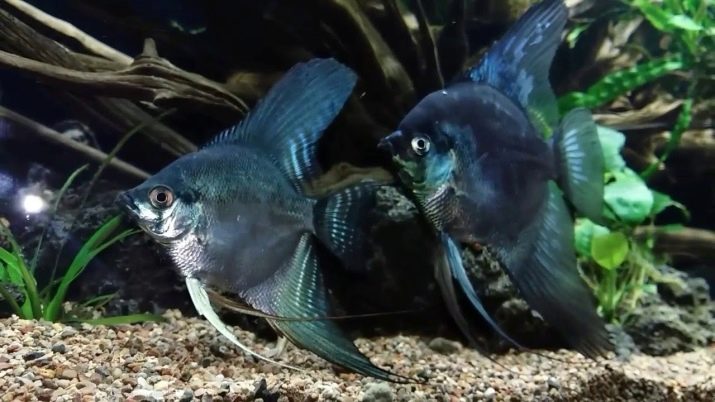
Plant a pre-selected pair of fish for spawning. After some time, the scalars will begin to "clear" the leaf - a clear sign that they are preparing a place for future eggs. To stimulate the fish, gradually raise the water temperature to +30 degrees. Spawning can be expected during the day.
If this "love union" was voluntary, then the scalar will make excellent parents. They take care of their caviar and protect it together, fanning them with fins. They clean out dead eggs.
The larvae emerge from the eggs on about the third day of spawning, and after that the period of parental care for them ends. A week later, the fry begin to swim behind their parents, huddling in flocks. At this time, you can start feeding them fish food.

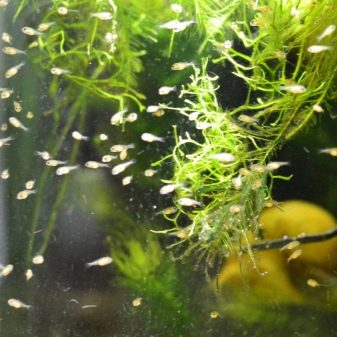
Compatibility with other fish
As already mentioned, the scalar independently chooses a "partner" for itself, therefore, several pairs of fish can be kept in one aquarium at once. As they grow older, each couple takes their favorite place and does not fight for territory.
If you have a small aquarium, it is better to leave only one pair of fish in it.
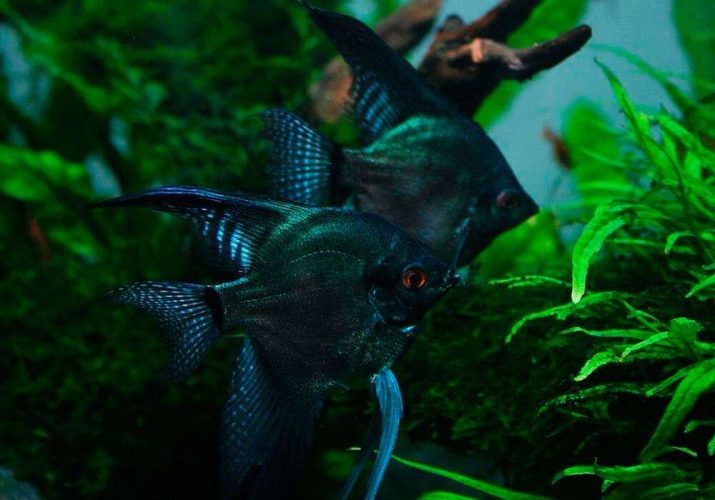
Although scalars are very calm individuals, they have bouts of aggression during spawning. In addition, it happens that they eat small fish. Do not forget that these are still predatory fish. Try not to add guppy or neon fish to them. However, if they "from childhood" were brought up and grew up with little brothers, they are not in danger of being swallowed.
Neighborhood with gourami and catfish will also not be a problem. In general, it is best to add different types of medium-sized fish to the scalars - velvet or veil-tailed fish get along quite well with them.
They also get along with peaceful large fish: labyrinth, rainbows.
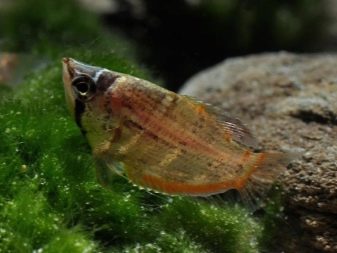
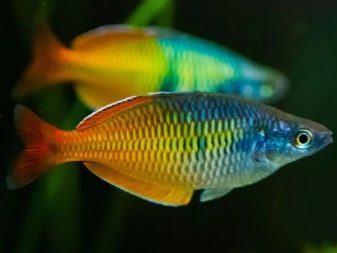
Scalarians do not like clumsy fish, as they themselves are quite active. Aggression can be caused by goldfish and other members of the cichlid family. Velvet scalars can rip their fins or harm their eyes.
It is undesirable to keep scalar with fish, which can bite off their thin fins. These are, for example, all kinds of cichlazomas.
For more on black scalars, see below.








